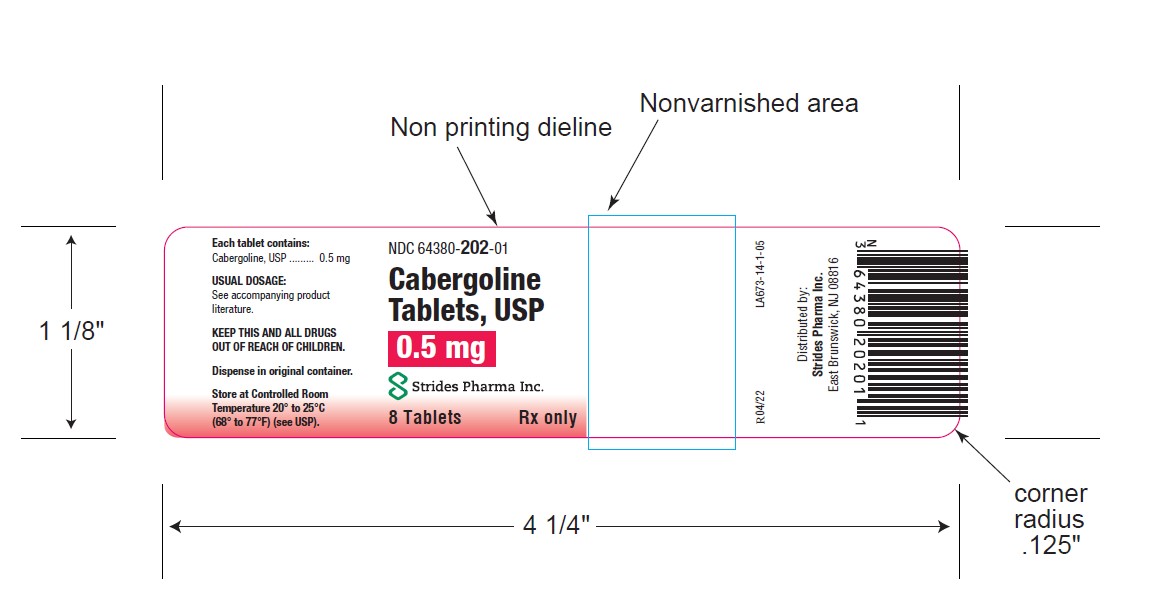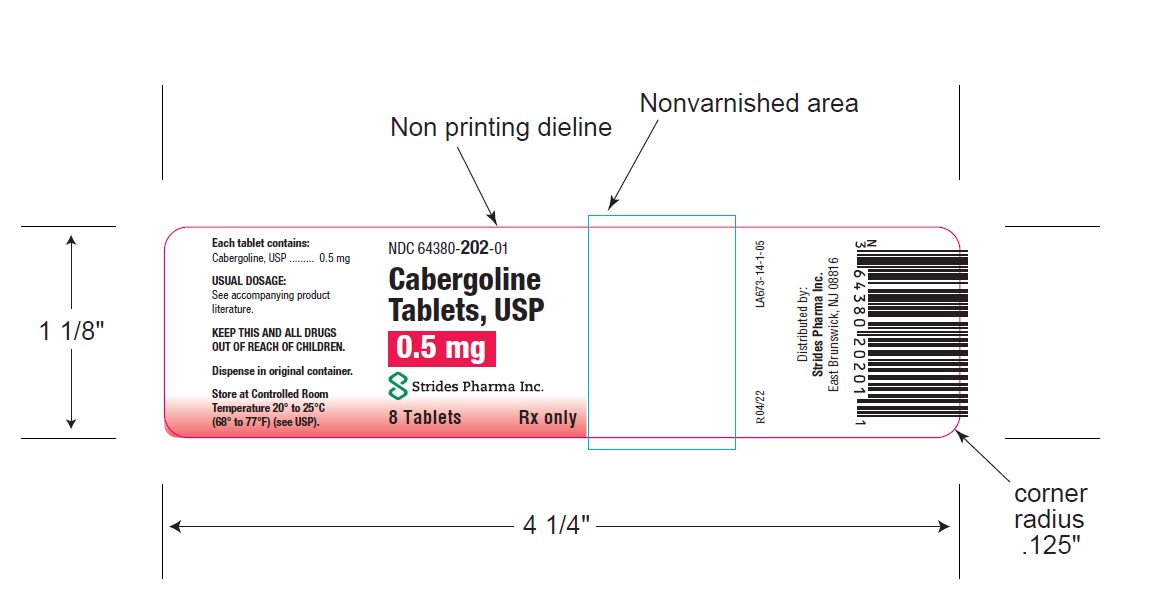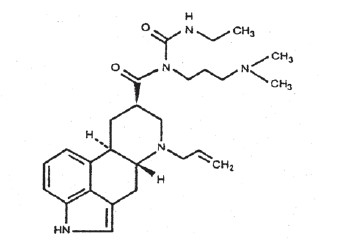General: Initial doses higher than 1.0 mg may produce orthostatic hypotension. Care should be exercised when administering cabergoline with other medications known to lower blood ...
General: Initial doses higher than 1.0 mg may produce orthostatic hypotension. Care should be exercised when administering cabergoline with other medications known to lower blood pressure.
Postpartum Lactation Inhibition or Suppression: Cabergoline is not indicated for the inhibition or suppression of physiologic lactation. Use of bromocriptine, another dopamine agonist for this purpose, has been associated with cases of hypertension, stroke, and seizures.
Hepatic Impairment: Since cabergoline is extensively metabolized by the liver, caution should be used, and careful monitoring exercised, when administering cabergoline to patients with hepatic impairment.
Psychiatric: Impulse control/compulsive behaviors, including pathological gambling, increased libido, and hypersexuality have been reported in patients treated with dopamine agonists including cabergoline. This has been generally reversible upon reduction of the dose or treatment discontinuation (see Post-marketing Surveillance data). Prescribers should consider dose reduction or stopping the medication if a patient develops such urges while taking cabergoline.
Information for Patients: Patients should be instructed to notify their physician if they suspect they are pregnant, become pregnant, or intend to become pregnant during therapy. A pregnancy test should be done if there is any suspicion of pregnancy and continuation of treatment should be discussed with their physician.
Patients should notify their physician if they develop shortness of breath, persistent cough, difficulty with breathing when lying down, or swelling in their extremities.
Patients should be alerted to the possibility that patients may experience intense urges to spend money uncontrollably, intense urges to gamble, increased sexual urges, and other intense urges and the inability to control these urges while taking cabergoline. Advise patients to inform their healthcare provider if they develop new or increased uncontrolled spending, gambling urges, sexual urges, or other urges while being treated with cabergoline (see PRECAUTIONS).
Drug Interactions: Cabergoline should not be administered concurrently with D2-antagonists, such as phenothiazines, butyrophenones, thioxanthenes, or metoclopramide.
Carcinogenesis, Mutagenesis, Impairment of Fertility: Carcinogenicity studies were conducted in mice and rats with cabergoline given by gavage at doses up to 0.98 mg/kg/day and 0.32 mg/kg/day, respectively. These doses are 7 times and 4 times the maximum recommended human dose calculated on a body surface area basis using total mg/m 2/week in rodents and mg/m2/week for a 50 kg human.
There was a slight increase in the incidence of cervical and uterine leiomyomas and uterine leiomyosarcomas in mice. In rats, there was a slight increase in malignant tumors of the cervix and uterus and interstitial cell adenomas. The occurrence of tumors in female rodents may be related to the prolonged suppression of prolactin secretion because prolactin is needed in rodents for the maintenance of the corpus luteum. In the absence of prolactin, the estrogen/progesterone ratio is increased, thereby increasing the risk for uterine tumors. In male rodents, the decrease in serum prolactin levels was associated with an increase in serum luteinizing hormone, which is thought to be a compensatory effect to maintain testicular steroid synthesis. Since these hormonal mechanisms are thought to be species-specific, the relevance of these tumors to humans is not known.
The mutagenic potential of cabergoline was evaluated and found to be negative in a battery of in vitro tests. These tests included the bacterial mutation (Ames) test with Salmonella typhimurium, the gene mutation assay with Schizosaccharomyces pombe P1 and V79 Chinese hamster cells, DNA damage and repair in Saccharomyces cerevisiae D4, and chromosomal aberrations in human lymphocytes. Cabergoline was also negative in the bone marrow micronucleus test in the mouse.
In female rats, a daily dose of 0.003 mg/kg for 2 weeks prior to mating and throughout the mating period inhibited conception. This dose represents approximately 1/28 the maximum recommended human dose calculated on a body surface area basis using total mg/m2/week in rats and mg/m2/week for a 50 kg human.
Pregnancy: Teratogenic Effects: Category B. Reproduction studies have been performed with cabergoline in mice, rats, and rabbits administered by gavage.
(Multiples of the maximum recommended human dose in this section are calculated on a body surface area basis using total mg/m2/week for animals and mg/m2/week for a 50 kg human.)
There were maternotoxic effects but no teratogenic effects in mice given cabergoline at doses up to 8 mg/kg/day (approximately 55 times the maximum recommended human dose) during the period of organogenesis.
A dose of 0.012 mg/kg/day (approximately 1/7 the maximum recommended human dose) during the period of organogenesis in rats caused an increase in post-implantation embryofetal losses. These losses could be due to the prolactin inhibitory properties of cabergoline in rats. At daily doses of 0.5 mg/kg/day (approximately 19 times the maximum recommended human dose) during the period of organogenesis in the rabbit, cabergoline caused maternotoxicity characterized by a loss of body weight and decreased food consumption. Doses of 4 mg/kg/day (approximately 150 times the maximum recommended human dose) during the period of organogenesis in the rabbit caused an increased occurrence of various malformations. However, in another study in rabbits, no treatment-related malformations or embryofetotoxicity were observed at doses up to 8 mg/kg/day (approximately 300 times the maximum human dose).
In rats, doses higher than 0.003 mg/kg/day (approximately 1/28 the maximum recommended human dose) from 6 days before parturition and throughout the lactation period inhibited growth and caused death of offspring due to decreased milk secretion.
There are, however, no adequate and well-controlled studies in pregnant women. Because animal reproduction studies are not always predictive of human response, this drug should be used during pregnancy only if clearly needed.
Nursing Mothers: It is not known whether this drug is excreted in human milk. Because many drugs are excreted in human milk and because of the potential for serious adverse reactions in nursing infants from cabergoline, a decision should be made whether to discontinue nursing or to discontinue the drug, taking into account the importance of the drug to the mother. Use of cabergoline for the inhibition or suppression of physiologic lactation is not recommended (see PRECAUTIONS section).
The prolactin-lowering action of cabergoline suggests that it will interfere with lactation. Due to this interference with lactation, cabergoline should not be given to women postpartum who are breastfeeding or who are planning to breastfeed.
Pediatric Use: Safety and effectiveness of cabergoline in pediatric patients have not been established.
Geriatric Use: Clinical studies of cabergoline did not include sufficient numbers of subjects aged 65 and over to determine whether they respond differently from younger patients. Other reported clinical experience has not identified differences in responses between the elderly and younger patients. In general, dose selection for an elderly patient should be cautious, usually starting at the low end of the dosing range, reflecting the greater frequency of decreased hepatic, renal, or cardiac function, and of concomitant disease or other drug therapy.
Close



